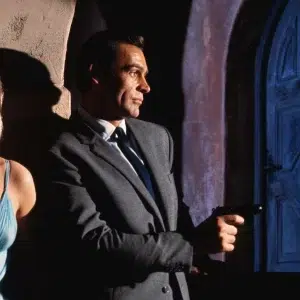‘Watchmen’: The Making Of The 1921 Tulsa Massacre
Damon Lindelof’s Watchmen explores an alternate history of the United States, but it all starts with a real-life, horrific event from the country’s past known as the 1921 Tulsa Massacre.
Both Lindelof and the episode’s director, Nicole Kassell, discussed how they brought the Tulsa Massacre to the screen. It’s an interesting discussion on how to use a real-life event as a jumping off point for an alternate history of the United States, and how to show the event through the eyes of fictional characters.
https://youtu.be/msXBygqdqxI
How Tulsa became the setting for ‘Watchmen’
For those familiar with the original Watchmen comic run and the subsequent graphic novel written by Alan Moore, or if you only saw Zack Snyder’s 2009 film adaptation, then you’ll remember the setting was New York City.
Lindelof wanted a different location for his series. “It seems like everything always takes place in one of two places [Los Angeles and New York],” he told Tulsa World. “And to ground ‘Watchmen’ and make it feel real, I’ve always thought ‘Watchmen’ was about America. So I had it in mind to pick a nontraditional place to set the show, and I was thinking ‘How would that look?'”
Tulsa entered the discussion after Lindelof read “The Case for Reparations” an essay written by Ta-Nehesi Coates. This was the first time the writer-producer heard about the Tulsa Massacre and the destruction of Greenwood District.
He was 43 or 44 at the time. He realized the massacre wasn’t common knowledge, ad after reading more on the subject. decided it should open Watchmen.
What Is The Tulsa Massacre of 1921?
On May 31, 1921, a white mob destroyed the prosperous black neighborhood called Black Wall Street. It all started after a young black man allegedly assaulted a white woman in an elevator. African-Americans assembled outside a courthouse to protect him from being lynched.
When shot were fired, the violence commenced. Black businesses were destroyed, and between 100 and 300 people were murdered by the Ku Klux Klan.
The destruction was like a battle from World War I. In 18 hours of mayhem, 35 square blocks were burned to the ground with firebombs, and a biplane shooting African-Americans from the sky.
It was a truly shameful event in American history that is not part of the curriculum in most American schools. Lindelof has probably introduced more people to the Tulsa Massacre than anyone by incorporating it into Watchmen.

Tulsa is Hooded Justice’s Krypton
Lindelof knew he had to adapt the event carefully. “I’m in a position now to potentially put this in a piece of popular entertainment and inform people about this actual historical event,” he told Den of Geek, “but I can’t be exploitative about it. It needs to be important.”
“It felt like it was very similar to the way that a lot of superhero stories or comic book storytelling starts, which is it’s the destruction of the world that you know,” he explained. “This felt a lot like Krypton or Bruce Wayne losing his parents. If you’re giving an audience vegetables, they’ll push them to the side of the plate, it has to feel like it’s as delicious as the rest of the meal. And more importantly, I think the more that the season goes on, the more pivotal we’ll see Tulsa ’21 was to our storytelling.”
As such the Tulsa Massacre is seen through the eyes of three fictional characters–‘The Father’ (Steven G. Norfleet) and ‘The Mother’ (Alexis Louder) and their young son (Danny Boyd Jr.)–as they move through the mayhem on Greenwood Avenue. Their son, who grows up to become the vigilante Hooded Justice, is secreted away to safety in the back of a truck.
Here, the parallels to Superman’s doomed parents sending their baby boy in an escape pod from Krypton to Earth seems fairly obvious.
Furthermore, this real event is key in establishing the alternate reality of Watchmen’s Tulsa in 2021, where a white supremacist militia called the Seventh Kavalry is facing off against vigilantes like Hooded Justice’s granddaughter, Angela.

Preparing For the Shoot
While this sequence is from the point of view of this fictional family as they move through the mayhem of the Tulsa Massacre, Watchmen’s executive producer and the pilot’s director, Nicole Kassell, made sure it was historically accurate. For reference she studied the book, The Burning: Massacre, Destruction, and the Tulsa Race Riot of 1921, which provided detailed and idiosyncratic eye witness accounts of the event.
These “vignettes” were incorporated into the script, and formed the background action in the sequence.
For visual accuracy, Kassell and the production team visited the Greenwood District. They spoke with historians at the Greenwood Cultural Center, where, in the archives, they found a rich resource of photographs and newspapers from the time of the massacre and it’s aftermath. Unfortunately, they couldn’t find a copy of the 31 May newspaper article sensationalizing the black man’s violence against the white girl, the usual kind of headline used to foment racial violence and lynching.
“That newspaper headline is what inflamed the mob,” Kassell told Vulture. “It was critical to me to get that headline in there, in as organic a way as possible.” In the sequence, you can see the headline being stomped on in the mayhem. “The title was ‘To Lynch Negro Tonight,’” added Kassell. “It was recalled and the original article ripped out … It was actively eradicated.”
Armed with detailed vignettes from the massacre, photographs of Greenwood Avenue where it took place, and also the headline which they found from another source, Kassell and her production team scouted for a suitable location.
They eventually found their location in a town in Georgia, where they built a set of Greenwood Avenue with accurate signage, storefronts and buildings like the Mount Zion Baptist Church and the Dreamland Theater.
The interior of Dreamland Theater is where the sequence starts after the boy watches a silent film of fictional black deputy U.S. Marshal Bass Reeves.
Filming the Tulsa Massacre
Kassell shot the sequence over two days. Before filming commenced the production team mocked up the set to rehearse the complex sequence. Rehearsals were split between Kassell, who worked with the core cast of the family, and her First Assistant Director, Keri Bruno, who worked with a small group of background actors. The background actors rehearsed the different vignettes Kassell had written into the scene.

A number of these actors became “kind of team captains” of these vignettes providing “psychological support and safety” for a total of 200 extras and stunt people who performed in these scenes.
Many of these vignettes are only on screen for seconds. “The man in a woman’s coat … the firemen being held back … all of those, I didn’t make anything up,” said Kassell. Some vignettes were staged but never made it into the final sequence including “a dog that ran by with its tail on fire. There were white spectators just watching. You know, white women just came to see the show.”
On the final day, stunts including men getting dragged across the ground, and a woman being thrown over a bench, were shot in three-minute extended takes of the family escaping. Cameras with long lenses hidden throughout the set caught the action. “It’s pretty amazing to me,” Kassell said, “how much we got in a very tight sequence.”
In a bizarre coincidence, the first day filming marked the 97th anniversary of the Tulsa Massacre. There was a level of respect on set with a priest blessing the production, and a board of the massacre’s history erected for people to reflect on.
For Lindelof and Kassell, re-creating the Tulsa Massacre was a complicated process. But their careful attention to history and the respectful treatment of the Tulsa Massacre has helped bring the attention of millions of Americans to an almost forgotten–but important– part of their history.
- Heart of Stone: Female Bond-Clone References Moonraker, On Her Majesty’s Secret Service and Other Bond Films - February 8, 2024
- How Editor Peter Hunt Saved ‘From Russia With Love’ - January 27, 2024
- This Periodic Table of Tropes Is The Ultimate Storytelling Infographic - January 22, 2024


